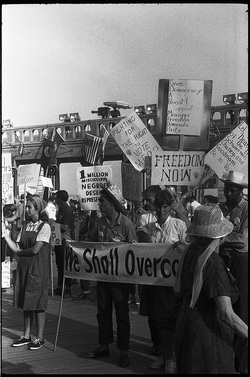 Mississippi Freedom Democratic Party supporters
Mississippi Freedom Democratic Party supporters hold signs reading, "We Shall Overcome" at the
1964 convention. (Library of Congress)
 Russell Willoughby
Russell Willoughby(Montgomery, Alabama)
Though optimism for a brighter future was a common theme, the lyrics evinced, too, the anguish associated with centuries of struggle: “Here’s to the state of Mississippi,/For Underneath her borders, the devil draws no lines,/If you drag her muddy river, nameless bodies you will find.” The spiritual songs of slaves were an important antecedent to the freedom songs and reflected these same tensions between faith and sorrow. Frederick Douglass, a former slave wrote, “The remark in the olden time was not unfrequently made, that slaves were the most contented and happy laborers in the world, and their dancing and singing were referred to in proof of this alleged fact; but it was a great mistake to suppose them happy because they sometimes made those joyful noises. The songs of the slaves represented their sorrows, rather than their joys. Like tears, they were a relief to aching hearts.”
Reading the stories and testaments to the uniting power of music in the context of the civil rights movement stressed, for me, the unwavering importance of art in forging and maintaining community when mere words do not suffice.
Russell Willoughby is a senior at the University of Alabama where she is pursuing a B.A. in English with a minor in French. She's a sucker for pretty words and parallel structure. And Mexican food.
References:
Douglass, Frederick. The Complete Autobiographies of Frederick Douglass
“Songs and the Civil Rights Movement,” Martin Luther King Jr. and the Global Freedom Struggle, The Martin Luther King Jr. Research and Education Institute
Wang, Hansi Lo, “50 Years Ago, Freedom Summer Began By Training For Battle,” NPR
 RSS Feed
RSS Feed